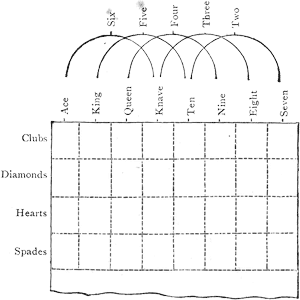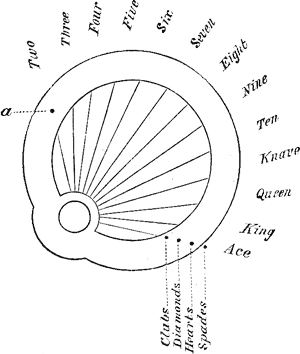
|
foreword to the online edition I. introductory II. common sharpers and their tricks III. marked cards and the manner of their employment IV. reflectors V. holdouts VI. manipulation VIII. the game of faro IX. prepared cards X. dice XI. high ball poker XII. roulette and allied games XIII. sporting houses XIV. sharps and flats
|
SHARPS AND FLATS
CHAPTER III MARKED CARDS AND THE MANNER OF THEIR EMPLOYMENT
§ C -- Marking by dot and punctureThe main outlines of this method will be understood from what has already been said. If the unglazed spots are represented by minute dots, the principle is practically the same. The only difference is in connection with marking by puncture. In this case the mark is made by pricking the card with a very fine needle upon its face. This raises a minute point or 'burr' upon the back, which can be detected by passing the thumb across the back of the card whilst dealing.
FIG. 4 -- Divisions indicating suit and value If a plate of metal the size of a playing-card is divided at each end into parallelograms, after the manner shown in fig. 4, these divisions will represent the positions occupied by the puncture or dot in representing the various suits and values. A small hole being drilled in the centre of each parallelogram, the plate will serve for a 'template' by means of which the cards may be pierced in the correct places. The plate is laid upon the face of the card, and a fine needle is pricked through the proper hole, just far enough to raise the necessary projection on the back of the card. One point at each end, then, will serve to mark all the cards of a picquet pack. If those cards which are lower than seven have to be marked, two points may be taken. For instance, a point in the top left-hand corner, together with one three divisions further to the right, will indicate the six of clubs. A point in the second space on the same line, with one in the fifth space, will represent the five of clubs, and so on. This is a very good system of marking for many purposes. It takes only a short time to mark the whole pack; the marks are invisible, and will escape the 1 closest scrutiny. But great practice is necessary to render the touch sufficiently acute, and the perception of the small differences sufficiently delicate, to read the marks with precision. Another method whereby a single dot is made to represent both suit and value of any card is illustrated in fig. 5. In every ornamental back almost, there is some portion of the pattern which is more or less of a fan-shaped or radial design. If this should happen to contain thirteen divisions, nothing is easier than to assign to each one a value, and thus the entire suit is represented by merely varying the position of the dot. The suit is given by placing the dot nearer or farther from the centre. Fig. 5 is a diagram which illustrates this method in its simplest form. A dot placed outside the periphery of the design stands for 'spades,' one just inside for 'hearts,' half-way between the two lines for diamonds,'and close to the inner circle it means 'clubs.' The value or 'size,' as it is called, is shown by the radial line, opposite which the mark is placed. Having followed this explanation, the reader will at once perceive that the dot marked a (fig. 5) represents the two of diamonds.
FIG. 5 Of course it frequently happens that there is no part of the pattern which contains thirteen divisions. Then, either more than one design must be used, or the form of the mark must be varied. Supposing there are only six divisions available for the purpose, the six highest cards can be indicated by a dot, the six next in order by a small dash, and the last by a minute cross.
|
| « marked cards... (...unprinted backs) | marked cards... (...marked in manufacture) » |
home | introduction | book content | links | advertising | contact

